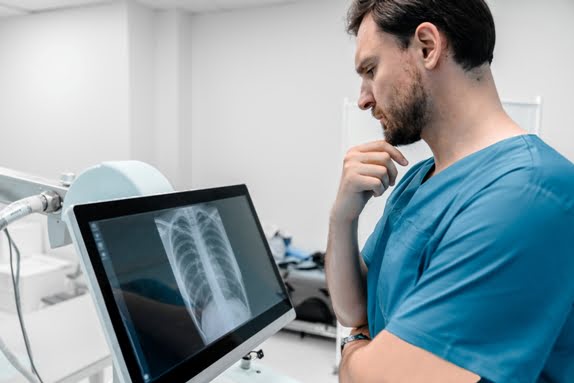Purpose and Indications
An X-ray of the Hip Joint One View is performed to assess the integrity and health of the hip joint. It provides valuable information about both the bony structures of the hip and any pathologies affecting the joint. Here are some of the main reasons an X-ray of the hip joint may be ordered:
1] Hip Fractures: One of the most common reasons for a hip joint X-ray is to detect fractures, particularly in elderly patients who may have fallen or experienced trauma. Fractures of the femur, acetabulum, or the area around the hip joint can lead to severe pain and difficulty moving the leg.
2] Osteoarthritis: Osteoarthritis (OA) is a degenerative joint disease that commonly affects the hip joint, especially in older adults. An X-ray can show joint space narrowing, the presence of bone spurs (osteophytes), or changes in bone density, which are characteristic signs of OA.
3] Hip Dysplasia: Hip dysplasia is a condition where the hip socket does not fully cover the ball of the thigh bone, leading to instability and possibly early-onset arthritis. A hip X-ray can help assess the degree of dysplasia and its effect on the joint.
4] Avascular Necrosis (AVN): AVN occurs when blood supply to the femoral head (the ball part of the hip joint) is disrupted, leading to bone death and collapse. X-rays can detect signs of AVN, such as changes in bone structure and density.
5] Infections or Inflammatory Conditions: Infections such as septic arthritis or inflammatory conditions like rheumatoid arthritis can affect the hip joint. An X-ray may show signs of joint destruction or other changes associated with these conditions.
6] Pre-surgical Evaluation: Before surgery, such as a hip replacement or joint reconstruction, an X-ray is often performed to evaluate the joint's condition, the extent of damage, and the best approach for surgery.
7] Monitoring Progress: For patients undergoing treatment for hip fractures, arthritis, or post-surgical recovery, periodic X-rays can monitor the healing process and ensure that the joint remains stable.
For a reliable X-Ray Hip Joint One View in Pune, Diagnopein is your nearby digital X-ray test centre. This X-ray provides clear images of the hip joint, helping detect conditions such as fractures, arthritis, dislocations, or other joint abnormalities. Utilizing the latest digital X-ray technology, we ensure high-quality images with minimal radiation exposure. Our experienced radiologists provide accurate and quick results to aid in effective diagnosis and treatment planning. Whether you’re dealing with pain, injury, or routine monitoring, Diagnopein offers the best services for your hip joint X-ray needs in Pune. Visit us for your trusted diagnostic needs.
Procedure and Technique
The X-ray Hip Joint One View is a relatively simple and quick procedure that usually involves the following steps:
1] Preparation: There is no special preparation required for the X-ray, though you may be asked to remove any clothing or metal objects (like jewelry) that might interfere with the imaging. You may be given a gown to wear during the procedure.
2] Positioning: The patient will typically lie on an X-ray table or stand in front of an X-ray machine, depending on the specific view needed. For a single view, two common positions are used:
A] Posterior-Anterior (AP) View: The patient lies on their back with the leg of the affected hip extended. This view provides a front-to-back image of the joint and is the most commonly used for hip X-rays.
B] Lateral View: The patient may be asked to lie on their side to obtain a side view of the hip joint. This view helps evaluate the hip joint from a different angle and is particularly useful for assessing fractures or dislocations.
3] Image Capture: The radiologic technologist will position the X-ray machine correctly to capture the hip joint area. The patient may be asked to hold their breath momentarily while the X-ray is taken to minimize motion blur. The technologist will ensure the image is clear before moving on.
4] Post-Procedure: After the X-ray is captured, the patient can typically resume normal activities. The X-ray images are then sent to a radiologist for evaluation. The radiologist will examine the images for any abnormalities and send a report to the referring physician.









